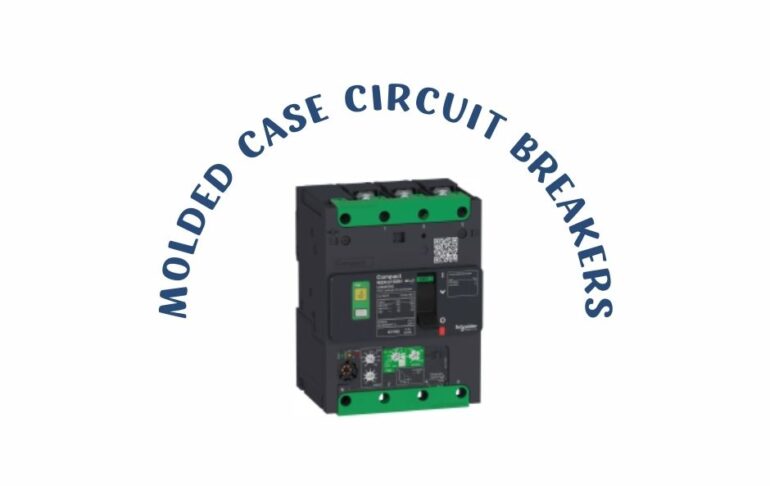
In the intricate world of electrical systems, the MCCB (Molded Case Circuit Breaker) stands as a stalwart guardian, ensuring the safety and reliability of circuits across various applications. In this comprehensive guide, we delve into the essence of MCCBs, unraveling their intricacies, and exploring how they differ from other types of circuit breakers.
Understanding the MCCB
- Defining the MCCB:
The MCCB, or Molded Case Circuit Breaker, is a versatile electrical protection device designed to safeguard circuits from overloads and short circuits. Housed in a molded case made of insulating materials, MCCBs are crucial components in electrical distribution systems. - Key Components of an MCCB:
An MCCB comprises essential components such as a trip unit, operating mechanism, contacts, and an arc-extinguishing system. The trip unit, in particular, plays a pivotal role in detecting abnormal conditions and initiating the opening of the contacts.
How MCCBs Differ from Other Circuit Breakers
- Construction and Design:
MCCBs are distinct in their construction, featuring a robust molded case that encapsulates the internal components. This design not only enhances durability but also provides insulation, ensuring safe operation in various environments. In contrast, other circuit breakers may have different designs, such as open-frame or enclosed constructions. - Trip Mechanisms:
One significant point of departure lies in the trip mechanisms. MCCBs utilize thermal and magnetic elements within the trip unit to respond to overloads and short circuits. Thermal elements react to prolonged overcurrents, while magnetic elements respond to sudden, high-intensity faults. Other circuit breakers may rely on different mechanisms, such as magnetic-only or electronic trips. - Adjustability and Customization:
MCCBs offer adjustability in their trip settings, allowing users to customize the response characteristics based on the specific requirements of the application. This adjustability provides a tailored approach to circuit protection, a feature that sets MCCBs apart from some other circuit breaker types with fixed trip settings. - Application Versatility:
MCCBs find application in a broad spectrum of environments, from residential to industrial settings. Their adaptability makes them suitable for a variety of circuits, including motor protection, feeder protection, and distribution board protection. This versatility distinguishes MCCBs from circuit breakers designed for more specialized applications.
Advantages of MCCBs
- Reliability and Durability:
The molded case design of MCCBs enhances their durability, protecting internal components from external factors and ensuring consistent performance over time. This reliability makes MCCBs a preferred choice for critical circuits. - Ease of Installation:
MCCBs are known for their user-friendly installation procedures. With standardized designs and clear markings, installing MCCBs is often straightforward, minimizing the risk of errors during the setup process. - Customization for Specific Applications:
The adjustability of trip settings allows MCCBs to be tailored for specific applications. Whether it’s a delicate electronic circuit or a robust industrial setup, MCCBs can be fine-tuned to provide optimal protection.
Selecting and Installing MCCBs
- Determining MCCB Ratings:
Choosing the right MCCB involves evaluating factors such as the prospective short-circuit current, load characteristics, and ambient temperature. Understanding these parameters helps in selecting an MCCB with the appropriate current rating and breaking capacity. - Installation Best Practices:
Proper installation is critical for the optimal performance of MCCBs. Following manufacturer guidelines, ensuring correct wiring, and adhering to safety protocols are crucial steps in the installation process.
Maintenance and Troubleshooting
- Routine Maintenance:
Regular inspections and maintenance routines are essential to ensure MCCBs remain in peak condition. This may include visual checks, testing of trip functions, and verifying the tightness of connections. - Troubleshooting Common Issues:
In the event of issues such as tripping or malfunctions, a systematic approach to troubleshooting is necessary. Identifying the root cause, whether it’s an overload, a short circuit, or a faulty trip unit, allows for effective resolution.
Conclusion: Embracing the Power of MCCBs
In the dynamic landscape of electrical systems, MCCBs emerge as stalwarts of reliability, offering a robust defense against electrical faults. Their distinct construction, versatile applications, and customizable features position them as indispensable components across diverse industries. Understanding the nuances of MCCBs not only ensures effective circuit protection but also empowers users to make informed decisions in designing and maintaining electrical systems. As we navigate the intricacies of modern power distribution, embracing the power of MCCBs becomes synonymous with ensuring a safer, more resilient electrical infrastructure.


